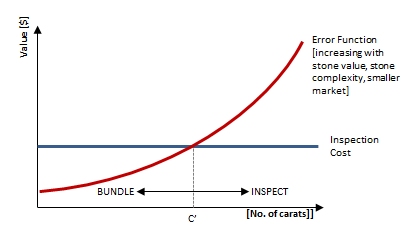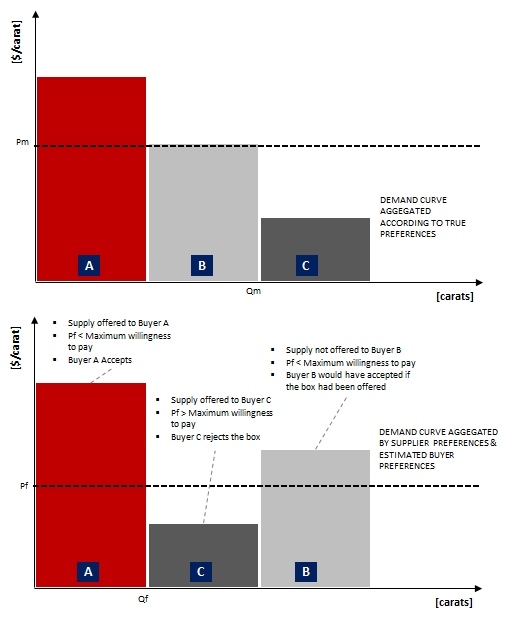Market design in the rough diamond market – seeing something new
The game of interaction between buyers and sellers of the diamond market is peculiar and inefficient. This article outlines the archaic market mechanism devised almost 100 years ago, which fails to reveal preferences and relies upon signals and screening to understand what the market participants really want to do. The market has begun to move away from supply discipline and the market game should move with it.
————————MARKET EFFICIENCY————————
GENERAL OVERVIEW
The price is an information transmitter to buyers and sellers. Buyers compare it against their willingness to pay and decide how much to purchase if at all. Sellers compare the market price against their cost structure and resource constraints to decide how much to produce. The dynamic effects of changing supply and demand through price signals move to an equilibrium where supply and demand balance at the market clearing price.
In order for markets to work effectively and distribute resources efficiently in this manner the method of interaction needs to be [as defined be Al Roth who received the 2012 Nobel Prize for his work in Market Design]:
- Thick – bring enough buyers and sellers to transact
- Uncongested – provide time to consider enough alternative transactions
- Safe – to reveal preferences
DIAMOND MARKET
OBSERVED INEFFICIENCIES
Unfortunately the diamond market and its use of sights fail to achieve from this structure. The seller offers stones within bundles of similar characteristics at a set the price which adjusts over time following feedback from buyers surrounding their total demand. Buyers are permitted to accept or reject the goods that are allocated to them, without negotiation.
The obvious problem with this method is that there is limited way for buyers to explicitly on preferences between stones. The system relies upon signalling and screening to transfer information between parties.
Buyers also suggest that demand exceeds supply – prices are set below the market clearing rate. Rejection rates are low (typically c10% up to a 25% rejection rate at a very poor sight). Again there is limited scope for the buyers to act and bid up prices such that the demand matches the supply on offer. It appears the sellers are giving away money in the form of lower prices.
CHARACTERISTICS OF THE DIAMOND MARKET
As with any investigation into appropriate market design, the underlying characteristics of the market in question lead to nuances and adaptations to try and make the system work as best they can. The diamond market has two clear characteristics that have seriously influenced the evolution of the market; supplier power and transaction costs.
1. SUPPLIER POWER – In the infant days of the diamond business, supply was closely held as a monopoly. The supplier was able to dictate the rules of the game and the system of sights were established which capitalised upon this fact
a] CONTROLLED ALLOCATION – De Beers minimise buyer power by allocating stones rather than handing them over to the highest bidder as determined by the market price.
b] COMPETITVE BUYERS – A large base of buyers was established (originally c300 and currently c80) who accepted what they were allocated or be replaced by another buyer. In order for this to be a game worth playing for the buyers, a small margin was factored into the supplier pricing (rough-polished price spread).
c] RESTRICTED VOLUME – Initial demand from consumers was lower (pre marketing drive for diamond engagement rings etc.) relative to available run of mine supply. In a luxury goods market a fine line must be taken between availability and exclusivity. The restricted supply of diamonds encouraged a market of exclusivity.
d] FORECLOSURE/EXCLUSION – Buyers are invited to become a sightholder, an opportunity that can be removed following a breakdown in the buyer–seller relationship
e] DEMAND ESTIMATION – Demand isn’t directly observable by the seller and thus they must estimate it based upon previous auctions, market signals etc. There will clearly be a margin of error around this estimate. If the demand estimate exceeds the true demand then the price set by the seller will exceed market clearing and a proportion of stones will remain unsold. Therefore, a margin for error might be included within the set price to make sure that the quantity of diamonds gets sold on most occasions.
2. HIGH TRANSACTION COSTS – Each stone has a large nominal value, each stone is unique and each stone can have multiple valuations. The direct costs of inspection and valuation are non-trivial [De Beers uses 550 full time sorters]. The risk of valuation error is also an important consideration for participants.
a] BUNDLING -In the current market the seller performs the valuation and bundles stones with similar characteristics together. The benefit of bundling allows for stone value variation within a category to cancel out – higher quality stones per category are offset by equivalent lower quality stones per category in the same bundle. This reduces the valuation risk and reduces the cost of search.
b] MINIMISE OVERSEARCHING – In a competitive auction. In order to arrive at a bid, each buyer would have to assess the quality of the stone and arrive at a value estimate. The cost of many buyers performing this activity will be significant. The accept or reject mechanism means that buyers are not incentivised to perform in-depth valuation of their own in order to find bundles of above average value and avoid lower than average value. As long as a slight margin buffer is in place and repeat purchases will be made, the buyers can expect quality to average out over the long run and avoid large losses if a below average bundle is accepted.
c] INFREQUENT INTERACTION – Interaction is chunked into blocks of selling effort at 10 sights per year which condenses valuation effort and minimise trips etc.
d] ENGAGE IN VALUABLE SEARCH – Transaction costs become outweighed as the stone value gets larger. Rough diamonds that exceed 10 carats as well as fancy stones (colour etc.) are subject to individual negotiations. In this case, the costs of valuation of a stone is outweighed by the risk of value lost through incorrect valuation. The risk mainly sits upon the seller’s side where a valuation of below the true value would lead to lost revenues. This can be remedied by letting buyers value the stone and reveal additional willingness to pay based upon their own valuations. A reserve price near the seller valuation can be used to avoid gaming. The risk transfers over to the buyer in the form of the “winners curse” where the highest bidder receives the stone, which under valuation uncertainty it is likely that the winner has overvalued the stone relative to competitors.
EVALUATION OF THE DIAMOND MARKET
Assessing relative to efficient market principles outlined above, the diamond market appears to be congested and unsafe. The take it or leave it approach to allocation means buyers are unable to consider alternative transactions. The fact that a buyer can be removed from the participant list by the seller means the market is far from a safe place, so buyers don’t fully reveal their preferences.
However, there is a great deal of signalling played by the buyers in order to secure better allocations of stones and this may go some of the way towards revealing preferences. A bigger challenge is that buyers can’t vote with their feet easily and reject boxes freely. They are more likely to hide their preferences. Inevitably a greater proportion of boxes priced at uneconomic prices would be rejected and prices would be adjusted, albeit in a slow and inaccurate manner because of the 5 week transaction cycle.
The market as it currently stands fails to allocate the correct stones to those who value them most highly and who would be willing to pay a higher price to secure them. It is up to the seller to distribute the stones and although lobbying takes place to try and express certain preferences, it is not a guaranteed way to efficiently allocate. The extent of the problem depends on how uniform or homogenous buyer preferences are.
The infrequent interaction mixed with the fixed price leads to a slow update to prices in order to get the market to clear appropriately. The price adjustment is clouded by the mix of historic actions (revealed preferences), signalled preferences and changing external factors like end product demand.
EXAMPLE OF FAILED ALLOCATION
The lack of revealed willingness to pay can lead to diamonds being offered to buyers who won’t buy them, while other buyers exist who would be willing but can’t get hold of them.
————————MARKET DESIGN————————
The rough diamond market has developed since the sight method was first developed in the 1920s with the introduction of additional supply sources and reduced monopoly power from De Beers. There is also a shift from high inventory and greater supply controls to leaner operations. Diamonds viewed at a sight are typically in the ground only 3 months before.
The allocation of diamonds under the current sight system is undertaken by the seller who takes in a number of pieces of information to decide who gets what; actual supply volumes (as determined by ROM), estimated demand volumes / qualities (from buyer signalling through lobbying), historic stone allocation, historic buyer behaviour, historic clearing prices volumes.
Recent market innovation has led to auction formats for a small proportion of diamond volume (e.g. De Beers markets 10% through the use of auctions). In this case, bundles are sold under a variety of auction mechanisms but all reveal the private willingness to pay.
BHP Billiton developed greater use of the use of the auction to inform the price paid under long term contracts. The sales channels vary between spot and term markets. Spot markets are one off auctions of a bundle. Term markets are indexed long term contracts (12+months) to ensure security of supply for buyers and sellers. In this case the buyer agrees to be a price taker for each delivery where the price is indexed to the spot market. The term market also has a premium or discount mechanism applied for the relative benefit or cost to the long term supply and acting as a price taker. Interactions so far have led to a premium being paid suggesting that the security of supply outweighs the reduced flexibility of price and quantity.
There is a clear need for a thick enough market in the spot arena to accurately fix prices for the term contracts. If the spot markets fail to gain a critical mass of representative participants then the market clearing price for the auction quantities alone is unlikely to be the market clearing price for the market as a whole.
It is also important that a mechanism is safe for the buyers to do reveal and will not be subject to price discrimination by the seller or ejected from the sightholder group entirely. While the pay as bid auction design maximise surplus for sellers in the short run, buyers become incentivised to reduce their bid towards the expected market clearing rate, another inefficient market mechanism.
More News
{{ commodity.name }}
{{ post.title }}
{{ post.date }}



Comments